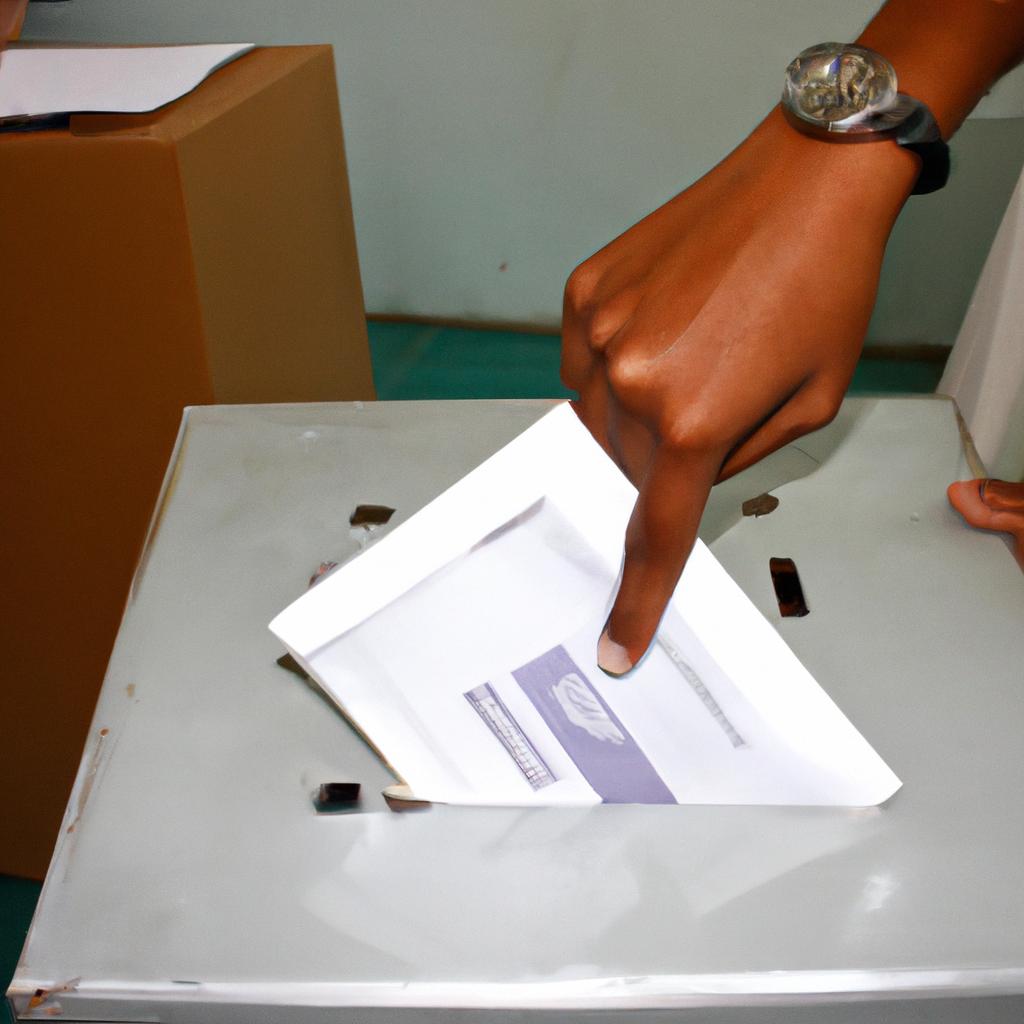Public opinion polls play a crucial role in political science as they provide valuable insights into the attitudes, preferences, and beliefs of the general population. These surveys are conducted by various social sciences organizations to gather data that can be used to analyze public opinion on specific political issues or evaluate the performance of politicians and governments. For instance, imagine a hypothetical scenario where an organization conducts a nationwide poll to gauge public sentiment towards a proposed policy reform. By collecting data from thousands of respondents across different demographic groups, this poll would offer researchers invaluable information about how individuals perceive and respond to potential changes in government policies.
The use of public opinion polls has become increasingly prevalent in political science research due to their ability to capture diverse perspectives within societies. Social sciences organizations employ rigorous methodologies when conducting these surveys, ensuring representative samples that accurately reflect the broader population’s opinions. Consequently, these polls have emerged as powerful tools for understanding societal dynamics and informing evidence-based policymaking. Furthermore, by tracking shifts in public opinion over time, researchers can assess the long-term impact of certain events or policies on society and identify patterns or trends that may shape future political landscapes. As such, an examination of public opinion polls provides crucial insights into the complex interplay between citizens’ views and political decision-making processes.
In In summary, public opinion polls serve as vital instruments in political science research by providing a comprehensive understanding of the attitudes and preferences of the general population.
Types of Public Opinion Polls
Public opinion polls are a crucial tool in political science research, providing valuable insights into the collective opinions and preferences of individuals within a society. These polls aim to capture the pulse of public sentiment on various social, political, and economic issues. Understanding the different types of public opinion polls is essential for researchers and policymakers alike.
One example that highlights the significance of public opinion polls is their role in forecasting election outcomes. By sampling a representative group of voters and gauging their voting intentions, pollsters can provide an early indication of which candidates or parties may emerge victorious. This not only helps shape campaign strategies but also influences media coverage and voter behavior during elections.
- Political affiliation: Polls often seek to determine how individuals align themselves politically, whether as conservatives, liberals, moderates, or members of specific parties.
- Policy preferences: Researchers use polls to gather data on people’s stances regarding various policy matters such as healthcare reform, immigration policies, climate change regulations, or taxation.
- Social attitudes: Public opinion surveys delve into societal beliefs about contentious issues like same-sex marriage rights, gender equality, racial discrimination, or gun control measures.
- Economic outlook: Polls frequently include questions related to economic conditions and individual financial situations. They help gauge people’s confidence in the economy and their views on job prospects or income inequality.
In addition to lists conveying information efficiently, tables serve as another effective way to present data concisely. The table below provides an overview of common methods used in public opinion polling:
| Method | Description |
|---|---|
| Telephone Surveys | Conducted via landline or mobile phones with trained interviewers asking respondents a series of questions. |
| Online Surveys | Administered through web-based platforms where respondents answer questionnaires independently without interviewer assistance. |
| Face-to-Face Interviews | Researchers personally engage with respondents, asking questions and recording their answers. This method ensures a more nuanced understanding of participants’ responses but can be time-consuming and expensive. |
| Mail Surveys | Questionnaires are sent by post to individuals who complete them at their convenience before mailing them back. Although cost-effective, this method often yields lower response rates. |
In summary, public opinion polls encompass various types that facilitate the study of collective opinions within a society. These surveys play a pivotal role in political science research, aiding in election forecasts and providing insights into policy preferences, social attitudes, and economic outlooks. Understanding the different methods employed to conduct these polls is crucial for researchers seeking accurate data on public sentiment.
Moving forward to explore the methodology for conducting public opinion polls, it is essential to delve into effective sampling techniques and strategies employed in gathering data from diverse populations.
Methodology for Conducting Public Opinion Polls
In the previous section, we explored the various types of public opinion polls used in political science research. Now, we turn our attention to the methodology employed when conducting these polls, which plays a crucial role in ensuring accurate and reliable results.
To illustrate the methodology behind public opinion polling, let us consider an example: a survey conducted by a renowned social sciences organization aiming to gauge public sentiment towards healthcare reform. This hypothetical poll employs a combination of telephone interviews and online surveys as its primary data collection methods. By using both modes of communication, researchers ensure that they capture opinions from individuals who may have different preferences or accessibilities regarding technology.
When designing and implementing a public opinion poll, several key considerations come into play:
-
Sampling Techniques:
- Random sampling allows for equal probability of selection among all members within a population.
- Stratified sampling ensures proportional representation by dividing the population into relevant subgroups based on certain characteristics (e.g., age or income) before selecting participants randomly from each subgroup.
-
Question Design:
- Closed-ended questions with response options provide quantitative data that can be easily analyzed.
- Open-ended questions encourage respondents to express their thoughts more freely but present challenges in analysis due to varying responses.
-
Data Collection:
- Telephone interviews offer quick data acquisition but may suffer from respondent bias or non-response issues.
- Online surveys allow for larger sample sizes and reduce interviewer effects but may exclude those without internet access.
-
Analysis and Interpretation:
- Proper statistical techniques are applied to analyze collected data and draw meaningful conclusions.
- Results should be interpreted cautiously, considering potential biases such as nonresponse bias or question wording effects.
By adhering to sound methodological practices like those outlined above, social scientists strive to minimize biases and produce robust findings that accurately reflect public opinion.
Moving forward, we will delve into the role of public opinion polls in informing political decision-making, shedding light on their significance and impact within the realm of governance.
[Transition sentence: In understanding how public opinion polls inform political decision-making…]
Role of Public Opinion Polls in Informing Political Decision-Making
Public opinion polls serve as essential tools for political scientists to gauge the sentiment and preferences of the general public. These surveys provide valuable insights into how individuals perceive various social and political issues, thus helping inform decision-making processes at all levels of government. To illustrate their significance, let us consider a hypothetical case study where a public opinion poll is conducted regarding citizens’ stance on climate change policies.
One example that showcases the impact of public opinion polls on political discourse is a survey aimed at understanding public attitudes towards climate change policies. The results reveal that a significant majority of respondents prioritize strong environmental regulations to combat global warming. This finding prompts policymakers to reevaluate existing policies and propose more stringent measures aligned with citizens’ concerns, thereby shaping the direction of future legislation.
The role of public opinion polls in informing political decision-making can be further highlighted through several key points:
- Democratization: By providing an avenue for citizen participation, these surveys promote democratic values by involving people in shaping governance decisions.
- Accountability: Public officials are held accountable when they recognize constituents’ opinions expressed through such polls, ensuring responsiveness to popular demands.
- Policy Evaluation: Feedback garnered from public opinion polls enables policymakers to evaluate the effectiveness of current policies and make informed adjustments or reforms accordingly.
- Representation: Public opinion polling helps ensure that diverse voices within society are considered during policy formulation, fostering inclusivity and equitable representation.
To visually emphasize the importance of public opinion polls, we present a table summarizing their influence on political decision-making:
| Importance | Impact |
|---|---|
| Democratization | Facilitates citizen engagement in governance |
| Accountability | Holds officials responsible for addressing constituent concerns |
| Policy Evaluation | Enables evidence-based assessment of existing policies |
| Representation | Ensures diverse perspectives are reflected in policy formulation |
In conclusion, public opinion polls play a crucial role in shaping political discourse by enabling policymakers to gauge public sentiment on key issues. These surveys democratize decision-making processes, hold officials accountable, facilitate policy evaluation, and promote equitable representation within governance. However, conducting these polls presents its own set of challenges that need to be addressed. In the subsequent section, we will explore the obstacles faced when conducting public opinion polls.
Moving forward, it is essential to acknowledge the inherent challenges associated with conducting public opinion polls. Understanding these hurdles allows for a comprehensive examination of the reliability and validity of poll results while developing strategies to overcome them effectively. Therefore, let us now delve into the complexities involved in carrying out accurate and representative public opinion polling.
Challenges in Conducting Public Opinion Polls
Public opinion polls play a crucial role in informing political decision-making by providing valuable insights into the preferences and perspectives of the electorate. These polls serve as tools for gauging public sentiment, helping politicians and policymakers understand societal concerns and shape their agendas accordingly. To illustrate this point, let us consider a hypothetical scenario: during an election campaign, a candidate is unsure about which policy issue to prioritize. By conducting a public opinion poll on various topics of interest, such as healthcare, education, or climate change, the candidate can identify the most pressing concern among voters and tailor their campaign promises accordingly.
To gain a deeper understanding of how public opinion polls contribute to informed decision-making within politics, it is important to explore some key aspects associated with these surveys:
-
Representative Sampling: A well-designed public opinion poll requires a representative sample that accurately reflects the demographics of the target population. This ensures that results are not biased towards any specific group but provide an accurate reflection of broader public sentiments.
-
Questionnaire Design: The effectiveness of a public opinion poll relies heavily on how questions are constructed. Careful consideration must be given to avoid leading or biased questions that could sway respondents’ opinions or skew the results.
-
Data Analysis: Once data is collected from poll respondents, rigorous analysis techniques are employed to extract meaningful insights. Statistical methods help researchers interpret survey results reliably and draw valid conclusions about public sentiments.
-
Dissemination of Results: Finally, ensuring transparency and accessibility in disseminating polling findings is critical for informing political stakeholders effectively. Timely sharing of data allows politicians and policymakers to make evidence-based decisions grounded in real-time information.
Table Example:
| Aspect | Importance |
|---|---|
| Representative Sampling | High |
| Questionnaire Design | Medium |
| Data Analysis | High |
| Dissemination of Results | Medium |
While public opinion polls hold great potential in informing political decision-making, it is important to acknowledge the challenges associated with conducting them. The next section will delve into these difficulties and shed light on ethical considerations in public opinion polling, providing a comprehensive understanding of the field’s intricacies.
[Transition sentence] Moving forward, we will now explore the challenges faced when conducting public opinion polls and consider the ethical considerations that underpin this crucial aspect of social science research.
Ethical Considerations in Public Opinion Polling
Having explored the importance of public opinion polls in political science, we now turn our attention to the challenges that researchers encounter when conducting these surveys. A case study on a recent election will help illustrate some of these difficulties.
Example scenario:
Imagine a team of researchers attempting to conduct a public opinion poll during a highly contested mayoral election. They aim to accurately gauge voter preferences and sentiments towards various candidates. However, they face several obstacles along the way, which hinder their ability to obtain reliable data.
Firstly, one challenge is sampling bias. Despite efforts to select a representative sample of voters, it is often difficult to account for all demographic factors that could influence opinions. The researchers must carefully design their sampling strategy by considering factors such as age, gender, ethnicity, education level, and geographic location. Failure to do so can result in an unrepresentative sample that skews the findings.
Secondly, response rate poses another hurdle. With increasing levels of survey fatigue and skepticism among individuals who are frequently approached for their opinions, many potential respondents simply choose not to participate or provide inaccurate responses. This non-response bias can introduce distortions into the final results and compromise the validity of the poll.
Thirdly, question wording and framing play a crucial role in shaping public opinion outcomes. Even subtle changes in phrasing or ordering of questions can lead to significant variations in responses obtained. Researchers must navigate this challenge by employing neutral language and avoiding leading questions that might prompt biased answers.
Lastly, logistical constraints such as limited resources and time pressures add further complexity to conducting large-scale public opinion polls. These surveys require substantial financial investments for hiring trained interviewers or implementing online platforms effectively. Additionally, gathering accurate data within strict timelines becomes challenging due to logistical considerations involved in reaching diverse populations efficiently.
To evoke an emotional response:
- Researchers feel frustrated when faced with unforeseen biases undermining the representativeness of their sample.
- Potential respondents may experience fatigue due to frequent survey requests, affecting their willingness to participate and potentially impacting democratic processes.
- The accuracy of public opinion results can be compromised by unintended bias introduced through question wording or framing.
- Limited resources and time pressures add stress to researchers striving for accurate data collection.
Table: Challenges in Conducting Public Opinion Polls
| Challenge | Impact |
|---|---|
| Sampling Bias | Unrepresentative findings |
| Low Response Rate | Distorted results |
| Question Wording | Biased responses |
| Logistical Constraints | Difficulties in gathering accurate data within timelines |
Transition into the subsequent section about “Future Trends in Public Opinion Polling”:
As we have examined the challenges faced by researchers in conducting public opinion polls, it is essential to consider how these obstacles might shape future trends in this field. By addressing these difficulties head-on, scholars can develop innovative techniques and methodologies that enhance the accuracy and reliability of public opinion polling.
Future Trends in Public Opinion Polling
Section Title: Future Trends in Public Opinion Polling
Having discussed the ethical considerations involved in public opinion polling, it is now essential to examine the future trends within this field. By exploring emerging methodologies and technological advancements, we can gain insights into the potential shifts that may shape the landscape of public opinion research.
One noteworthy trend on the horizon is the increased utilization of artificial intelligence (AI) in survey design and analysis. Imagine a scenario where AI algorithms are employed to identify patterns and correlations within large datasets, allowing for more accurate predictions of voter behavior or policy preferences. This application of AI not only has the potential to improve efficiency but also raises concerns regarding data privacy and algorithmic bias.
Furthermore, as society becomes increasingly interconnected through digital platforms, online surveys are expected to continue their rise in popularity. Online platforms offer several advantages over traditional methods, such as cost-effectiveness, wider reach, and faster data collection. However, caution must be exercised when interpreting findings from online polls due to issues like self-selection bias and fraudulent responses.
To illustrate these emerging trends visually:
Emotional Response Bullet Points:
- Increased accuracy through AI algorithms
- Concerns about data privacy and algorithmic bias
- Advantages of online surveys: cost-effectiveness, wider reach, faster data collection
- Limitations of online polls: self-selection bias, fraudulent responses
Emotional Response Table:
| Trend | Pros | Cons |
|---|---|---|
| Utilization of AI | Improved prediction accuracy | Data privacy concerns |
| Online Surveys | Cost-effective; Wider reach | Self-selection bias; Fraudulent responses |
In conclusion,
The future holds immense potential for public opinion polling with the integration of advanced technologies such as AI and continued reliance on online survey platforms. While these developments promise greater accuracy and efficiency in collecting valuable societal insights, ethical considerations surrounding data privacy, algorithmic bias, and the limitations of online polls must be taken into account. As researchers navigate these future trends, it is imperative to strike a balance between utilizing innovative methodologies and upholding ethical standards in order to ensure reliable and trustworthy public opinion data for political science research.




